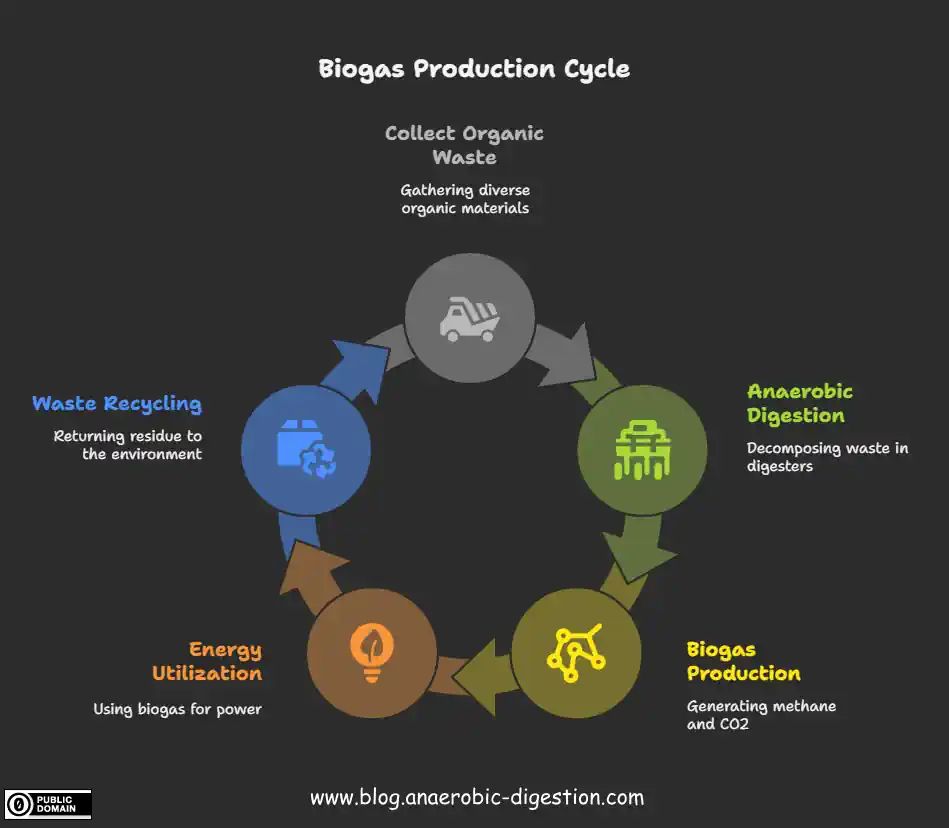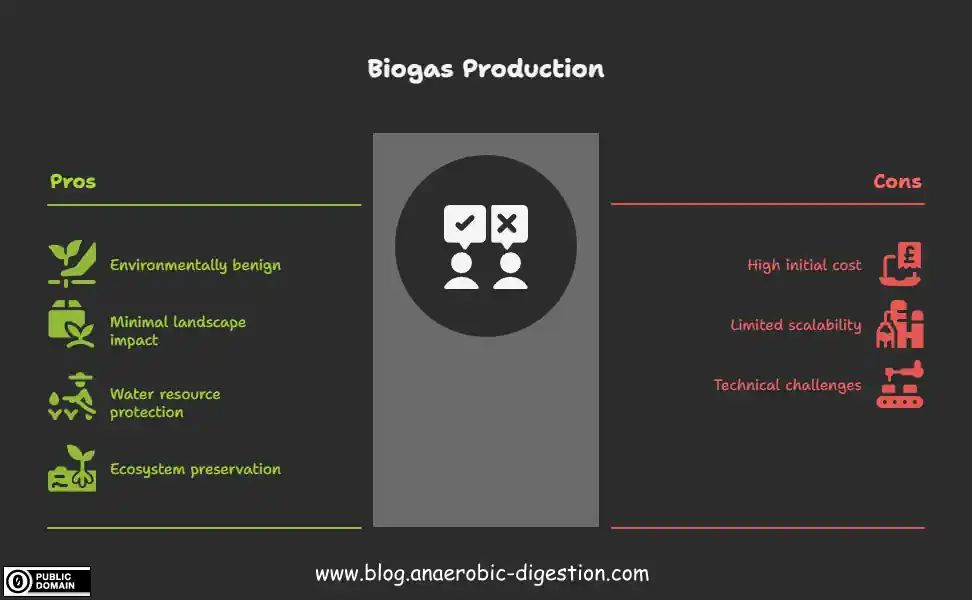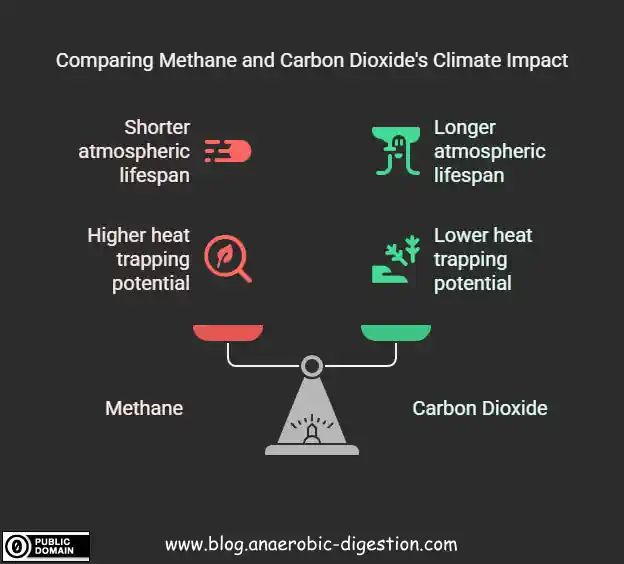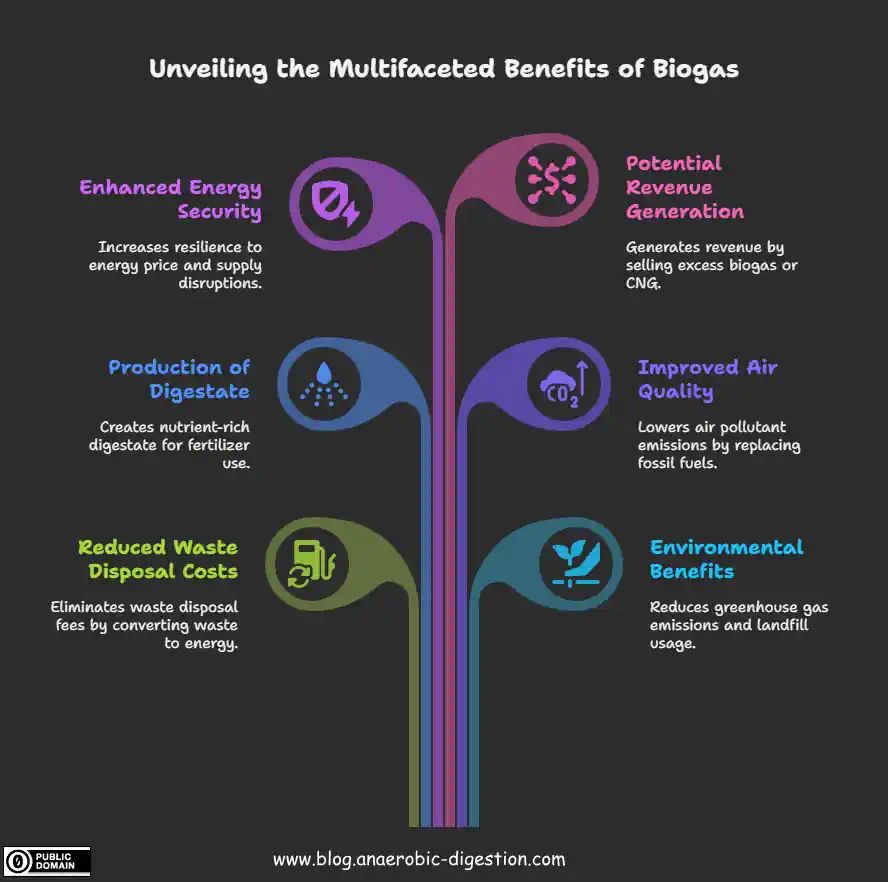Biogas is an excellent fuel because it's a renewable, carbon-neutral energy source (or close to it) that reduces waste and climate-warming greenhouse gas emissions by utilising organic materials like manure and food scraps instead of fossil fuels.
It can be used for heat, electricity, and cooking, and its refined form, biomethane, can use existing gas infrastructure. Additionally, biogas production offers benefits like nutrient-rich fertiliser byproduct and enhanced energy security by providing local, decentralised energy. Plus lots of decent local jobs etc., so we suggest that you read on to find out more…
Key Takeaways About Why Biogas is Considered an Excellent Fuel
- Biogas produces no smoke when burned, making it one of the cleanest renewable fuels available with minimal environmental impact.
- With up to 75% methane content, biogas delivers exceptional heating potential and high calorific value, producing significant heat per unit mass.
- The anaerobic digestion process that creates biogas simultaneously solves waste management challenges by converting organic waste into valuable energy.
- Unlike other renewable energy sources, biogas production operates continuously regardless of weather conditions, providing reliable 24/7 energy access.
- Biogas energy is helping communities worldwide implement sustainable biogas systems that reduce carbon footprints while creating economic opportunities.
The search for clean, renewable energy sources has never been more urgent as we face escalating climate challenges.
Among the various alternatives to fossil fuels, biogas stands out as a particularly remarkable option that delivers multiple benefits while addressing several environmental concerns simultaneously. This natural energy powerhouse is revolutionising how we think about waste and energy production.

Biogas: The Clean Energy Champion You Need to Know About
Biogas represents one of the most versatile and environmentally friendly fuel sources available today. It's a naturally occurring mixture of gases—primarily methane (50-75%) and carbon dioxide (25-50%)—produced when organic matter breaks down in an oxygen-free environment. This process, known as anaerobic digestion, happens naturally in landfills, marshes, and even in the digestive systems of cattle, but we've learned to harness and accelerate it through biogas digesters.
What makes biogas truly exceptional is its circular nature. Unlike fossil fuels that extract finite resources from the earth, biogas transforms what would otherwise be waste into valuable energy. From farm animal manure to food scraps, sewage, and agricultural residues, almost any organic material can become the feedstock for biogas production. EcoEnergy Solutions has been at the forefront of developing efficient biogas systems that help communities convert their organic waste streams into clean, renewable energy.

What Makes Biogas Different from Fossil Fuels
The fundamental distinction between biogas and conventional fossil fuels lies in their carbon footprint and sustainability profile. While coal, oil, and natural gas release carbon that has been locked away for millions of years, biogas only releases carbon that was recently captured by plants during photosynthesis. This creates a closed carbon cycle that doesn't contribute additional greenhouse gases to the atmosphere.
When burned, biogas produces no smoke and leaves no residue—a stark contrast to the polluting emissions associated with fossil fuels. Its combustion generates primarily water vapor and carbon dioxide, with virtually no sulfur dioxide or particulate matter that contribute to air pollution and respiratory problems. This clean-burning nature makes biogas an excellent fuel for cooking, heating, electricity generation, and even transportation.
Additionally, biogas doesn't require environmentally damaging extraction methods like drilling or mining. Its production occurs above ground in controlled digesters, eliminating the landscape destruction, water contamination, and habitat disruption associated with fossil fuel extraction. This gentle environmental footprint represents a fundamental shift in how we can approach energy production.
The Simple Science Behind Biogas Production
At its core, biogas production mimics and optimises a natural biological process. When organic matter decomposes without oxygen present, specialised microorganisms break down complex molecules through several stages. First, bacteria convert carbohydrates, proteins, and fats into simpler compounds. Then, acid-forming bacteria transform these into organic acids, which methane-producing microorganisms (methanogens) finally convert into biogas.
This entire process takes place inside sealed vessels called anaerobic digesters, which maintain the oxygen-free environment necessary for these specialised microbes to thrive. Modern biogas systems carefully control temperature, pH, and mixing to maximise

gas production. Depending on the feedstock and system design, the digestion process typically takes between 14-40 days to complete, continuously generating biogas throughout.
“The beauty of biogas lies in its simplicity—it's essentially capturing the energy stored in organic waste that would otherwise be lost. The same process that would release methane into the atmosphere from decomposing waste in landfills is instead harnessed to produce clean, renewable energy while reducing greenhouse gas emissions.” — Environmental Engineer, Waste-to-Energy Division
7 Powerful Environmental Benefits of Biogas
The environmental advantages of biogas extend far beyond its clean-burning properties. As we face increasing challenges from climate change and environmental degradation, biogas offers multiple ecological benefits that position it as a frontrunner in sustainable energy solutions. For instance, Denmark's biogas energy co-operative showcases how biogas can be integrated into farming and contribute to biomethane production for the grid.
1. Drastically Reduces Greenhouse Gas Emissions
Perhaps the most significant environmental benefit of biogas is its ability to capture methane that would otherwise escape into the atmosphere. Methane is a greenhouse gas approximately 25 times more potent than carbon dioxide in terms of its warming potential over a 100-year period. When organic waste decomposes in landfills or open manure lagoons, it releases substantial amounts of methane directly into the atmosphere. Biogas systems capture this methane and convert it into energy, effectively transforming a powerful greenhouse gas into a valuable resource.
The net effect is a double climate benefit – not only do we prevent methane emissions, but we also reduce the need for fossil fuel extraction and combustion. For farms with livestock, this can reduce their carbon footprint by up to 50%, making biogas an essential tool in our climate action toolkit.

2. Turns Waste into Energy
Biogas production exemplifies the circular economy in action. Materials that were once considered problematic waste – like food scraps, agricultural residues, and animal manure – become valuable energy resources. This waste-to-energy conversion eliminates disposal problems while simultaneously generating renewable energy, creating a perfectly circular solution.
Consider that a single dairy cow produces about 120 pounds of manure daily. For a farm with 200 cows, that's 24,000 pounds of waste every day that requires management. By directing this waste to a biogas digester, farmers transform a liability into an asset, generating electricity, heat, and even vehicle fuel.
3. Produces Nutrient-Rich Fertiliser as a Byproduct
After organic matter passes through the anaerobic digestion process, what remains is a nutrient-rich liquid called digestate. This material makes an excellent natural fertiliser that can replace synthetic chemical fertilisers on farms. The digestion process breaks down complex nutrients into forms more readily available to plants, while also reducing pathogens and weed seeds present in the original waste.
Farmers who use this digestate report improved soil health, better water retention, and reduced dependence on petroleum-based fertilisers. This creates yet another environmental benefit by reducing the energy and emissions associated with manufacturing synthetic fertilisers and by improving soil carbon sequestration.
4. Minimises Landfill Waste
Food and organic waste account for a substantial portion of materials sent to landfills – approximately 30-40% in many regions. When this organic matter decomposes in landfills, it produces methane that often escapes into the atmosphere despite landfill gas capture systems. By diverting organic waste to biogas digesters, we can significantly reduce landfill volumes, extending the lifespan of existing facilities and reducing the need for new ones.
Many municipalities are now implementing organic waste collection programs specifically to feed biogas digesters, keeping these valuable materials out of landfills entirely. This approach to waste management creates a more sustainable cycle where what we once threw away becomes clean energy and returns to enrich the soil.
5. Improves Local Air Quality
Beyond its climate benefits, biogas production improves local air quality in several ways. The enclosed digestion process significantly reduces odours from manure and other organic wastes compared to traditional storage methods like open lagoons or compost piles. This makes biogas systems particularly valuable in agricultural areas where odour management is often a challenge.
When used as a fuel, biogas burns much cleaner than coal, oil, or even conventional natural gas. It produces virtually no particulate matter and very low levels of nitrogen oxides and sulfur dioxide – pollutants associated with respiratory problems and acid rain. In rural areas of developing countries, replacing wood or dung burning with biogas for cooking has dramatically improved indoor air quality and reduced respiratory diseases. To learn more about the environmental benefits, check out this article on anaerobic digestion and its environmental impact.

The Economic Advantages That Make Biogas Shine
Beyond its environmental merits, biogas delivers compelling economic benefits that make it an attractive energy option for various sectors. From cost savings to revenue generation, the financial case for biogas continues to strengthen as technology improves and implementation costs decrease.
Lower Energy Costs for Homes and Businesses
For facilities that generate significant organic waste – like farms, food processing plants, and wastewater treatment facilities – on-site biogas production can substantially reduce energy costs. Many operations generate enough biogas to meet most or all of their electricity and heating needs, dramatically cutting utility bills. This energy self-sufficiency provides a hedge against rising energy prices and supply disruptions, creating long-term financial stability.
Residential biogas systems, particularly popular in rural areas of developing countries, allow households to produce their own cooking fuel instead of purchasing or gathering alternatives like propane, charcoal, or firewood. The initial investment in a small-scale digester typically pays for itself within 2-3 years through fuel savings alone, making it an economically viable option even for low-income communities.
Job Creation in Rural Communities
The biogas industry creates diverse employment opportunities, especially in rural areas that often struggle with economic development. Jobs range from system design and construction to ongoing operation, maintenance, and organic waste collection. Unlike many renewable energy systems that require minimal staff after installation, biogas plants need consistent operation and management, creating permanent local jobs.
The Economic Advantages That Make Biogas Shine
The economic case for biogas grows stronger each year as technology advances and implementation costs decrease. From farms to municipalities to industrial facilities, the financial benefits make biogas increasingly attractive to forward-thinking organizations and communities.
Lower Energy Costs for Homes and Businesses
For facilities producing significant organic waste, biogas systems provide impressive cost savings. A mid-sized dairy farm with 500 cows can generate enough biogas to power not only its own operations but potentially neighbouring homes as well. This energy independence protects against utility price fluctuations while providing a reliable power source regardless of weather conditions or grid stability.
In rural communities across developing nations, small household biogas systems have transformed family economics. A simple 6-cubic-meter digester can convert kitchen waste and animal manure into enough cooking gas for a family of five, eliminating the need to purchase traditional cooking fuels. This saves the average household $300-500 annually while providing a cleaner, healthier cooking environment. Learn more about why biogas is considered an excellent fuel.
Job Creation in Rural Communities
The biogas industry creates diverse employment opportunities across the entire value chain. For every megawatt of installed biogas capacity, approximately 4-5 permanent jobs emerge in operations, maintenance, and feedstock management. These positions offer stable employment in rural areas where job opportunities may otherwise be limited, helping revitalise local economies.
Beyond direct employment, biogas projects stimulate ancillary businesses in equipment manufacturing, transportation, laboratory services, and engineering. This multiplier effect strengthens regional economic resilience while building expertise in renewable energy technologies.
Reduced Waste Management Expenses
For municipalities and businesses, waste disposal represents a significant expense. Tipping fees at landfills continue to rise as available space diminishes, with costs typically ranging from $50-100 per ton. By diverting organic waste to biogas production, organisations can substantially reduce these disposal costs while generating valuable energy and fertiliser.
Many food processing companies have discovered that on-site biogas digesters transform their waste stream from a liability into an asset. Rather than paying for disposal, they generate energy that powers their facilities while producing a high-quality fertiliser they can sell to local farmers, creating a new revenue stream from what was previously considered waste.
How Biogas Provides Energy Independence
In an era of geopolitical uncertainty and energy security concerns, biogas offers a compelling path toward greater self-reliance. Unlike many energy sources that depend on global supply chains or distant resources, biogas can be produced locally from readily available materials.
On-Site Energy Production Capabilities
One of biogas's most remarkable qualities is its ability to enable decentralised energy production. Farms, industrial facilities, and communities can generate electricity and heat right where it's needed, eliminating transmission losses and infrastructure vulnerabilities associated with centralised energy systems. This distributed generation model creates a more resilient energy network, less susceptible to widespread outages or supply disruptions.
Modern biogas systems can be designed to match the specific energy needs of their host facilities. Combined heat and power (CHP) systems capture both electricity and thermal energy from biogas combustion, achieving efficiency rates up to 85% compared to the 35-40% typical of conventional power plants. This maximises the value extracted from each unit of biogas produced while meeting multiple energy needs simultaneously.
Reducing Reliance on Imported Fuels
For nations dependent on imported fossil fuels, biogas represents an opportunity to strengthen energy security and improve trade balances. By harnessing locally available organic materials, countries can reduce foreign energy purchases while keeping energy dollars circulating in the domestic economy. This reduced dependence on external energy sources provides greater economic stability and resilience against global market disruptions.
Sweden offers an inspiring example of this transition, having successfully converted nearly all of its city buses to run on biogas produced from municipal and agricultural waste. This shift eliminated the need for imported diesel fuel while simultaneously solving waste management challenges and improving urban air quality. The country now aims to become completely fossil-fuel-free by 2045, with biogas playing a crucial role in this energy transformation.
Biogas vs. Other Renewable Energy Sources
While all renewable energy sources offer environmental benefits, biogas brings unique advantages that complement other clean energy technologies. Understanding these distinctions helps identify where biogas fits most effectively in a diversified renewable energy portfolio. For example, Denmark's innovative approach to biogas energy co-operatives showcases how biogas can be effectively integrated into national energy strategies.
Comparing Biogas to Solar Power
Unlike solar energy, which is inherently intermittent and depends on daylight hours, biogas production continues 24/7 regardless of weather conditions. This constant generation capacity makes biogas particularly valuable for providing baseload power—the minimum amount of energy needed around the clock. While solar panels require significant land area for utility-scale projects, biogas digesters have a relatively small footprint and can often be integrated into existing agricultural or industrial facilities.
However, solar power generally offers lower operational complexity once installed. Biogas systems require continuous feedstock management and more active monitoring than solar arrays. The technologies work beautifully in tandem—solar providing peak daytime power while biogas ensures round-the-clock energy availability.
How Biogas Stacks Up Against Wind Energy
Wind energy shares some similarities with solar in terms of intermittency, though wind turbines can generate electricity day and night when conditions are favourable. Like biogas, wind power offers excellent carbon reduction benefits, but wind farms typically require specific geographic conditions and considerable land area. Biogas digesters, by contrast, can be built virtually anywhere organic waste is available, making them suitable for diverse geographic contexts.
Wind energy typically delivers lower generation costs at utility scale, but biogas compensates with its waste management benefits and production of valuable byproducts. Communities seeking to develop local renewable energy resources often find that a combination of technologies provides the most resilient and effective solution.
The Advantage of 24/7 Energy Production
Perhaps biogas's most significant competitive advantage is its ability to provide dispatchable power—energy that can be produced on demand whenever needed. This makes biogas exceptionally valuable for grid stability as more intermittent renewables like solar and wind are integrated into energy systems. Utilities increasingly recognise the value of consistent, controllable renewable generation that can balance supply fluctuations from weather-dependent sources.
In remote areas without reliable grid connections, this consistent generation capability makes biogas an ideal foundation for microgrids serving communities or industrial facilities. The stable power output ensures critical systems remain operational regardless of external conditions, providing energy security that intermittent renewables alone cannot match.
Real-World Success Stories: Biogas in Action
Across the globe, biogas systems are proving their value through successful implementations that demonstrate both environmental and economic benefits. These real-world examples illustrate how biogas technologies can be adapted to diverse settings and needs.
Family Farms Powering Their Operations with Biogas
The Straus Family Creamery in California represents a pioneering example of farm-based biogas success. Their system processes manure from 300 dairy cows, generating enough electricity to power the entire farm and creamery operation. The digester prevents methane emissions equivalent to removing 1,600 cars from the road annually, while the resulting digestate provides natural fertiliser that has allowed the farm to eliminate synthetic fertiliser use. This integrated approach has improved profitability while advancing the farm's sustainability goals.
In Wisconsin, Crave Brothers Farm combines cheese production with biogas generation, creating a closed-loop system where whey from cheese-making joins manure in their digester. The resulting biogas powers not only their farm but also their cheese factory, with excess electricity sold to the local utility. Their system generates enough electricity for 300 homes while preventing thousands of tons of greenhouse gas emissions annually.
Communities Taking Control of Their Energy Future
The village of Jühnde in Germany became one of the world's first bioenergy villages by establishing a community-owned biogas plant that provides heat and electricity to all 750 residents. Powered by locally grown energy crops and agricultural residues, the system meets 100% of the village's heating needs and produces twice the electricity the community consumes. This community-based approach has created local jobs, reduced energy costs for residents, and eliminated dependence on imported fossil fuels.
In India, the town of Namakkal transformed its poultry waste management challenges into an energy opportunity. With over 1,000 poultry farms in the region, disposal of chicken litter was a significant environmental problem. Today, several biogas plants process this waste into electricity, providing power to thousands of homes while improving local environmental conditions. The project demonstrates how biogas can simultaneously solve waste management challenges while meeting energy needs.
Industrial Applications Reducing Carbon Footprints
Heineken's brewery in Manchester, UK, implemented an innovative wastewater-to-energy system that converts brewing effluent into biogas. This system now supplies 40% of the facility's thermal energy needs, significantly reducing natural gas consumption and carbon emissions. The project achieved a payback period of less than five years while helping the company progress toward its carbon neutrality goals.
In Oregon, the Port of Portland installed a biogas system at its international airport to process food waste from terminals and nearby businesses. The resulting biogas powers a combined heat and power system that provides electricity and heating for airport facilities. This approach diverts waste from landfills while reducing the airport's energy costs and carbon footprint, showcasing how transportation hubs can integrate biogas into their sustainability strategies.




